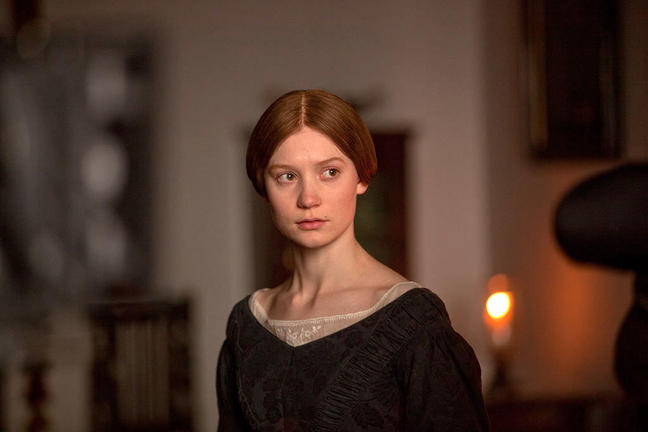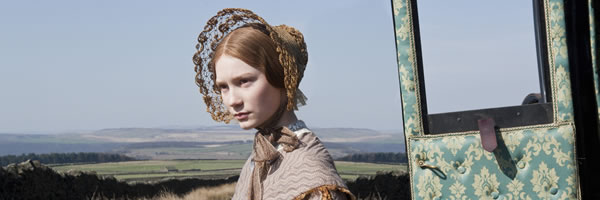"What's your tale of woe? All governesses have their tale of woe." If you're at all familiar with Jane Eyre, you know that she's got a doozy. But when the stern Mr. Rochester (Michael Fassbender) asks this of his relatively new governess, she downplays her woeful backstory. One of the great strengths of this latest Jane Eyre, written by Moira Buffini and directed by Cary Fukunaga, is that it too downplays some of the Gothic excess inherent in Charlotte Bronte's novel. This allows for a better focus on one of the great heroines of 19th-century literature, who sometimes is lost amidst the privation and suffering of her youth and the dramatic goings-on at Thornfield Hall - you know, the brooding guy with the crazy wife in the attic.
All the better that Jane be played by Mia Wasikowska. The lovely young actress (The Kids Are Alright, Alice in Wonderland) has had her hair dyed red and been rendered more plain to play the role of Jane. Charlotte Bronte's heroine is fascinating for her complexity, particularly given her age. There is the obvious intelligence, candor, fortitude and individualism. But there is also a sense of propriety that is fairly unique to someone who clearly desires a fuller, not more provincial life experience. Any conspicuous sense of morality is so often a prim and pretty covering thrown over a rather dreary table. This is a young woman who can make morality exciting. Altogether, it's a complexity, a richness of character that you wouldn't expect to easily cohere in someone forty years old, much less someone on the tender side of twenty. Ms. Wasikowska manages to evince it all. All of that, and as Rochester says, "You have rather the look of another world about you.” One of the many feats to which Mia Wasikowska is more than equal.
 This Jane Eyre also manages to rescue Mr. Rochester from the refuse heap of literary bad boys, a collection to which the Bronte sisters have at added at least a couple of illustrious corpses. The bilious fellow can easily drift into charicature, but there's no such danger with Moira Buffini's sympathetic rendering of the master of Thornfield, together with Michael Fassbender's intense but focused portrayal. We need to believe not only Rochester's severity, but the kernel of humanity and healthy passion that Jane reaches. As with his performance as Bobby Sands in Hunger, Mr. Fassbender's gleaming blue eyes would seem to indicate a fire within.
This Jane Eyre also manages to rescue Mr. Rochester from the refuse heap of literary bad boys, a collection to which the Bronte sisters have at added at least a couple of illustrious corpses. The bilious fellow can easily drift into charicature, but there's no such danger with Moira Buffini's sympathetic rendering of the master of Thornfield, together with Michael Fassbender's intense but focused portrayal. We need to believe not only Rochester's severity, but the kernel of humanity and healthy passion that Jane reaches. As with his performance as Bobby Sands in Hunger, Mr. Fassbender's gleaming blue eyes would seem to indicate a fire within. Fassbender might be well disposed to these extreme types, but watch also his work in Fishtank. There's something ultimately louche in the seductive charm of his Connor in Andrea Arnold's 2009 film, bedding the confused girl to whom he was providing some deserpately needed fatherly warmth. But for all that, his bad behavior was all the more ugly for how average he seemed. Bookended with the Irish hunger striker and haunted fellow from the north of England, it shows some range.
It's interesting that director Fukunaga has said that he actually wanted to play up some of the more Gothic elements of the story, some of the spookiness. Fortunately, where this occurs, it's more a matter of mood than circumstance. There is a sooty blast from a fireplace when the young Jane (Amelia Clarkson) is locked in a room at Gateshead by her abusive aunt (Sally Hawkins). Later, after the difficult years at Lowood School, during her early days as governess at Thornfield, a restless, melancholy Jane goes out for a walk. All is forbidding outside the great house: fog drifts into the scene as if on cue, there is the requisite abrupt disturbance of some ominous bird, complete with screech and flapping of wings (that one certainly got me) and finally an encounter with a mysterious man and his rearing horse, which throws its rider. The dark man on the dark steed is, of course, Mr. Rochester.
Beyond the occasional nod to the supernatural, there is little more than the occasional bump in the night on the part of the wretched Bertha, Rochester's first wife. Even her somewhat vampiric attack on her visiting brother, Roger, is treated with restraint. We (and Jane) see only the frightening and bloody aftermath, followed by a few forboding knocks from a behind a nearby wall. The episode is rife with possibilites of excess which are judiciously avoided. A good part of the credit belongs also to the script of Moira Buffini. This version begins with Jane's flight from Thornfield and is told mainly in flashback. The flashbacks are long enough to create a sense of continuity, but the breaking up of Bronte's narrative keeps the darker, potentially hysterical elements of the story from gaining too much momentum.
The belching fireplace, the screeching bird, poor young Jane made to stand on the "pedestal of infamy" at Lowood School...all well and Gothic good. Less so the purgatory which finds Jane aided and ultimately pursued by the dour St. John Rivers (Jamie Bell), during which she frequently hears her name whispered by wind about her. It would have been only slightly sillier had the wind cried Mary.
Much more significant than any of the Gothic trappings Mr. Fukunaga tries to emphasize is the moorland landscape of north central England that he and cinematographer Adriano Goldman capture so beautifully.
Much of this occurs as the film begins with Jane's flight from Thornfield. There is the rain darkened knot of branches outside her window, the lonely crossroads at which carriage tracks converge and finally the inland sea of grass, bracken and the crumbly, iridescent soil of the moors at which Jane has her moment of greatest despair. Rarely has this wild, otherworldly part of England been so powerfully evoked. Just as rare is a demonstration of hard it must have been to simply walk from one point to another through such an area without aid of a path. So it is with Jane as she slogs through the long, coarse grass while the rain pelts her mercilessly.
Restrained though the touch may be, this is still a tempest of a story. But all involved have managed to fasten the shutters long enough so we can focus on the extraordinary young woman who lends her name to the enterprise. Not to mention the classic romance which is in no way diminshed by its greater than usual credibility. If you groan at the thought of another Jane Eyre, this might be a good place to return to the story. If you have always been a fan, be grateful that the baton has been picked up by such sure hands.
db







Comments
Post a Comment